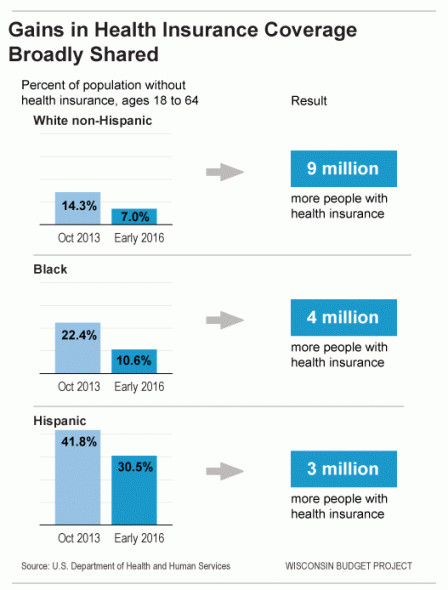Six Achievements of Obamacare
Including a 43% drop in uninsured non-elderly adults and 76 million more getting preventive care.

Former Health and Human Services Secretary Kathleen Sebelius and President Barack Obama. Official White House. Photo by Pete Souza.
The federal health care reform law turned six today, and for a relatively young law it has made remarkable progress in reducing the number of uninsured Americans and improving access to quality, affordable health care. A WCCF blog post outlines some of the data illustrating the Affordable Care Act’s accomplishments, and for the law’s sixth birthday I’ve distilled those into the six achievements described below.
Of course, the law has its detractors – including many Republican officeholders and candidates who seek to repeal it. During the election campaigns in the months ahead, I hope there will be robust debate about the laws effects – grounded in solid data. I hope the proponents of repealing the ACA will explain how they would replace it and how they would improve upon, or at least avoid reversing, the following accomplishments:
1. There have been huge gains in health insurance coverage
- There has been a net reduction of 20.0 million uninsured adults over the past six years, according to the Dept. of Health and Human Services (HHS), and a 43% drop in the uninsured rate for non-elderly adults since the fall of 2013. (Read more here.)
- Census Bureau data show that about 100,000 fewer Wisconsinites were uninsured in Wisconsin in 2014 (a 19% drop in one year), and the Marketplace enrollment figures suggest that there have been significant gains in coverage since then. (See this Sept. 2015 blog post.)
2. Access to preventive care has improved
- Most of us are benefiting from the fact that the ACA made nearly 76 million Americans newly eligible for free preventive care. (Read more here.) Broader access to preventive care improves health, reduces spending for more costly health care interventions, and saves lives.
3. Gains in coverage have been strong across all racial and ethnic groups
- The bar graph helps illustrate that the drop in the uninsured rate among non-elderly adults since the fall of 2013 has been very strong across all racial and ethnic groups – with a decline of 53% among Blacks, almost 51% among Whites, and 27% for Hispanics.
4. Hospitals’ uncompensated care costs are much lower, which avoids cost shifting to other health care consumers
- Hospital uncompensated costs were reduced by an estimated $7.4 billion (21%) in 2014, according to an HHS analysis, and in Wisconsin those costs fell by $42 million (15.3%) in 2014, compared to 2013 (according to data from the WI Hospital Association).
5. Seniors are saving on prescription drugs costs
- The ACA has saved seniors billions of dollars by reducing their share of costs in Medicare prescription drug plans. HHS estimated a year ago that in the first five years after enactment of the ACA , 9.4 million seniors and people with disabilities saved over $15 billion on prescription drugs, an average of $1,598 per beneficiary.
- The savings are now well over $5 billion per year and will grow much larger until 2020, when the ACA completely closes the so-called “donut hole” in Medicare drug plans.
6. People with pre-existing conditions can get affordable insurance
- The ACA enables people to sign up for insurance through the federal Marketplace, even if they’ve been unable to before because they have pre-existing conditions. That’s a huge accomplishment, and it’s something that can’t be achieved without a comprehensive health care reform plan like the ACA.
The ACA isn’t perfect, and I certainly hope that Congress and the next president will objectively review the data that sheds light on the law’s strengths and weaknesses. I also hope next year they will work together to ensure that we keep moving toward, not away from, the goal of improving access to quality, affordable health care.





















